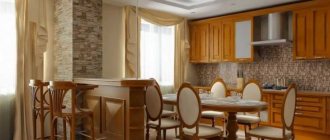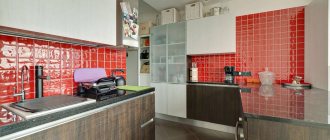Housing planning is the first and fundamental stage of construction, assessing the comfort of the existing apartment layout is a fundamental point when purchasing it. More recently, residents of the post-Soviet space, one after another, “tried for themselves” the newfangled idea of partial globalization of living space - combining the kitchen with the living room. Some people liked this option as it suited the family’s way of life, while for others the innovation did not bring the expected convenience. Nevertheless, the world does not stand still, and modern designers are taking even more radical measures to improve the layout - turning an ordinary apartment into a studio apartment..
- 2.1 Table: characteristics of a studio apartment in comparison with a regular apartment
- 3.1 Photo gallery: for whom a studio apartment is ideal
- 4.1 Procedure for legalizing redevelopment
- 5.1 Video: how a family with a child lives in a small studio apartment
What is a studio apartment
Neither the housing legislation of the Russian Federation nor state building codes define the concept of “studio apartment”. Nevertheless, this fact in no way prevents the active use of the concept in practice - this kind of residential premises is widely represented both in the economy segment and in the luxury housing market.
A studio apartment is not only luxury housing, but also small-sized housing
A studio apartment is a living space that does not have internal partitions (except for the most necessary ones - those that hide the bathroom from view). The studio apartment is the newest trend in the field of housing design, solving many not only aesthetic, but also practical spatial problems. Among the most obvious ones:
- optimization of space - exclusion of low-functional areas;
- visual expansion of space;
- improved lighting;
- increasing the suitability of the premises for rapid transformation;
- adaptation of the premises to the needs of its owner.
The fast pace of modern life (especially in megacities) does not allow a person to spend a significant part of his time at home. With the advent of smart technology and systems for managing “home” processes, the functions of a person in caring for an apartment and his household duties are gradually being simplified and minimized. In this regard, there is a desire to simplify space - not to waste time and effort on moving from one room to another, to combine some processes in time and space (cooking and communicating with other family members, etc.)
A little history
Decorating studio apartments is a relatively new trend in interior design for post-Soviet countries. In the 10s of the 21st century, this trend began its development in Western European countries and gradually “leaked” to the East. Nevertheless, the very concept of a global unification of space in the world is not new.
A group of architects from the USA became innovators in the field of radical rethinking of living space back in the 1920s of the 20th century. Since then, the history of the appearance of studio apartments has been associated with the name of the group’s leader, Ludwig Mies van der Rohe. The essence of the idea was to “string” the floors on the axis, thereby getting rid of load-bearing structures inside the room. The idea was later refined by A.V. Purgin in the 60s of the XX century.
The new design solution instantly gained popularity among the creative youth of those years - it fully met the needs of an extraordinary person, not burdened with family concerns, and, moreover, embodied the spirit of freedom in everyday life.
At the same time, studio apartments with slightly different functional purposes and social orientation appeared in Japan. Premises without partitions of minimum permissible dimensions were built en masse for the temporary residence of workers away from home. This format helped save space, and also corresponded to the needs of a person who devotes most of his time and energy to work rather than to everyday life.
Some caveats and additions
If you have a large family or a family with small children, a standard studio apartment is absolutely not suitable for you. The lack of privacy and personal space will negatively affect family relationships, and if you already live in such an apartment, try to make sure that this is a temporary measure.
One more thing. In this article we are talking about standard studios, which are now sold by all developers in the country. But there are also studios that are located in luxury housing complexes. These are large studios with panoramic windows and magnificent views from them. Perhaps even with terraces and swimming pools. Although this type of housing is also called a studio apartment, its functionality differs from the well-known twenty-meter apartments. For such apartments, the pros and cons of living will be completely different.
Main characteristics of a studio apartment as opposed to a conventional living space
As noted, a studio apartment differs from an ordinary one in only one (however, very global) aspect - the absence of internal partitions. However, functionally this is a completely different housing. Starting to describe the general characteristics, let’s focus on the types of studio apartments.
The sleeping area in a studio apartment is usually hidden in a niche
Conventionally, depending on the configuration and location of functional areas (in particular, the key one - the kitchen), apartments with a single space can be divided into the following groups:
- Premises that have a regular (square or rectangular) shape, where the kitchen area is not hidden in a niche, but is located along one of the walls (usually opposite the entrance) - completely or partially.
- Apartments equipped with a kitchenette, hidden (fully or partially) by a corner, turn or screen.
- Apartments where the kitchen (or other areas) are highlighted by changing the floor level relative to the remaining areas.
Photo gallery: types of studio apartments
Table: characteristics of a studio apartment in comparison with a regular apartment
| Characteristic | Studio apartment | Regular apartment |
| Room area, perception of area | From the very minimum footage to huge areas, which fully corresponds to the spread of areas of ordinary apartments from different market segments. Nevertheless, the dimensions of the room are perceived “exactly the opposite”:
| As you know, ordinary apartments today are presented in a wide range of areas. Dividing a small area into separate rooms (fragmentation) greatly visually reduces each of the rooms. But on the other hand, a larger number of individual locations psychologically “increases” housing. As for crushing a large area, it reduces the space, but makes it more comfortable, “intimate”, “warm”. |
| Saving space due to the elimination of hallways, corridors, passages | The exclusion of rooms that perform “passage” and “dividing” functions allows you to optimize the space. | Auxiliary premises in an ordinary apartment play an inconspicuous, but important role for some families:
|
| Number of functional zones, their delimitation | A studio apartment allows you to create additional functional areas (for example, a bar counter). In addition, these zones do not have a clear demarcation; they can overlap each other, appear as a result of transformation (completely or partially). Zones in an ordinary apartment, as a rule, You can arrange various functional areas in a studio apartment in a completely non-trivial way - in the place where the situation allows it, where it is convenient. | An ordinary apartment imposes some restrictions on the number and location of functional areas. Thus, the decision to place a play area for a child in the kitchen would seem somewhat strange, although for the mother this decision is very convenient and completely justified. Zones in an ordinary apartment, as a rule, are limited in location to one room; many of them cannot intersect with each other, thereby saving space. |
| Possibility of space transformation | A studio apartment is the most favorable layout option for all kinds of transformations. It is very easy to move furniture in such a room, so you can think through possible combinations of functional areas in advance. For example, the dining area can be converted from a living room during lunch. The same living room can be turned into an area for physical exercise (by moving furniture towards the walls), into a play space for children, etc. | The possibility of transforming space in an ordinary apartment is limited to individual rooms. Of course, modern industry offers a lot of furniture options in the format of so-called transformers (they can be used both in a studio apartment and in an ordinary apartment). But creating a space limited only by the perimeter of the apartment will not work here. |
| Noise and sound insulation, the ability for apartment members to comfortably do their business | The lack of partitions in a studio apartment significantly limits the privacy of the residents. In such a room it is difficult for people with different interests, different regimes, people of different ages and generations to coexist. | For a large family consisting of several generations, the ideal option is an ordinary multi-room apartment. Each family member (or several of the same age) has their own separate location, where, quite independently, without disturbing anyone, they can have a separate daily routine and perform different functions. |
| Possibility of combining several household chores and communication, observation | The single space of a studio apartment makes it possible to combine several activities with one person. The wife, being in the kitchen, can freely communicate with her husband, who is seated watching TV, and watch the child’s games. At the same time, it will be very difficult to put the child to sleep during the day in such an environment. | The distribution of family members among apartment rooms in connection with their household responsibilities and interests deprives them of communication with each other. As for small children, their presence in another room without the supervision of elders can even be dangerous. |
| Lighting (intensity, ratio of natural and artificial light) | The open space of a studio apartment promotes the unhindered distribution of natural and artificial light from all its possible sources. Such apartments are always brighter; artificial light is used less often. However, often one source of artificial light for the entire room is not enough, but planning and uniform distribution of lamps throughout the apartment in this case can cause some difficulties. | Some rooms in an ordinary apartment are out of reach of natural light sources (entrance hall, corridor). The rest, as a rule, have only one (maximum two) windows, which means they are not illuminated from all sides, unevenly. Meanwhile, artificial lighting is easier to plan here - almost always one central illuminator and several additional ones (optional) are enough. |
| Providing storage space | The combined space of a studio apartment practically eliminates the presence of a storage room. There may also not be enough space for cabinets in such a space, because they are usually located along the walls, and the walls in the studio are only around the perimeter. Nevertheless, modern designers offer completely innovative storage solutions - shelves, cupboards, cabinets are installed in furniture niches, on podiums, in staircase steps, in the space under the stairs | In an ordinary apartment, storage systems can be equipped in a way that is quite familiar to everyone - a pantry, cabinets, chests of drawers in any room. |
| Difficulties in interior design | Correct and practical zoning of a studio apartment is a task for a professional. In the case of a studio apartment, simply placing furniture around the perimeter of the room will not work. Only a specialist designer is able to “squeeze” benefit and comfort from every centimeter of space, take into account all the nuances, and offer original solutions. A single space has a drawback - it is impossible to apply several interior styles and even several incompatible color schemes here. | Decorating the interior of each individual room is a task that is entirely within the capabilities of the average person. Of course, a designer interior is the best solution in any case. However, not everyone can afford it. |
Several solutions for such an apartment
Photo of a decorated apartment in loft style
So, a studio apartment, what is it and how can you arrange the interior?
The design of the apartment can be chosen in any style, but most often it is:
- Minimalism.
- Modern.
- Loft.
They look most organic in an open space and will be relevant even years later.
What should be present in the room:
- Furniture transformers.
- Kitchen sets with built-in appliances.
- A bar counter instead of a dining table, that's what you need to get used to.
- No twin beds.
- Stylish sofas.
- And modern chairs.
Furniture is often placed along the walls or becomes a partition in the house itself.
You can use several ways to divide space into zones:
- Using color.
- Mobile partitions and furniture.
- Different levels in the apartment.
If you have skills in landscaping and repairs, then you can make such a studio apartment yourself, but you will have to run around with obtaining permits for housing redevelopment.
Features of redevelopment of a studio apartment and an ordinary apartment into a studio
It's no secret that over time a person gets tired of any environment, even if it was once loved. In an ordinary apartment, in such a case there are many options for resolving the problem:
- rearrangement of furniture;
- changing the functional purpose of living rooms (relocating residents from one room to another);
- repair;
- redevelopment of the apartment.
In general, each of the listed options is suitable for a studio apartment. The “softest” option in this case is rearranging the furniture. However, it should be understood that as furniture moves, functional areas also move, some of them may disappear altogether. Therefore, it is necessary to think over new zoning in advance, preferably with the involvement of a professional designer.
The softest option for remodeling a studio apartment is moving furniture and functional areas
Changing the functional purpose of rooms in a studio apartment equates to a more global shift of zones than with rearrangement. Unfortunately, this option is rarely possible in small studios. Well, in large ones, the flight of imagination is limited only by the location of communications (water, gas, sewerage, etc.).
Studio renovation, like a similar case with a regular apartment, is a complete or partial replacement of interior finishing elements. Difficulties with renovating a single space can arise quite prosaically - the need to move out of the apartment for a while. Indeed, unlike a multi-room apartment, in a studio it is simply impossible to “relocate” to another room. On the other hand, the studio will require much less finishing materials - after all, the area of the partitions of a regular apartment is taken away.
Redevelopment of a studio apartment can only mean converting it into a one-room or multi-room apartment. It should be understood that this procedure is complex not only physically and financially, but mainly legally. In order to build new walls, it is necessary to go through several stages of approval and registration. By the way, the same procedure should be followed when remodeling an ordinary apartment into a studio.
Converting an ordinary apartment into a studio is not at all as simple a task as it might seem at first glance. You should remember about the presence of communications in the demolished walls (wiring, sockets, etc.) and the need to radically change the plan for their distribution throughout the room.
Procedure for legalizing redevelopment
All actions related to the demolition and construction of partitions inside even one’s own home are subject to mandatory approval by the authorized local authorities (Housing Commission of the territorial unit). At the same time, redevelopment can be either allowed or prohibited.
Any redevelopment should be based on a project or at least a sketch
Important! It is theoretically possible to bypass the approval of redevelopment, but in the future it will be impossible to perform a single legally significant action with such an apartment - sell, exchange, donate, inherit, etc. If a discrepancy between the actual layout of the housing and the available technical documentation is discovered, the owner is held administratively liable for unauthorized redevelopment (with the imposition of an administrative fine) and is forced to eliminate all changes made - Art. Art. 7.21, 7.22 Code of Administrative Offences.
In addition, you should know that redevelopment will not be allowed in cases where the following can be seen from the project:
- abolition of load-bearing partitions;
- deterioration of the living conditions of neighbors (for example, when moving a bathroom or kitchen to an area located above the neighbors’ living quarters);
- increased electricity or water consumption;
- changing the facade of the building;
- use of devices incompatible with the current communications system.
To start the redevelopment approval procedure, you must collect the following documents:
- remodeling project (if the project is made incorrectly, permission may be denied);
- application for redevelopment (on a standard form) - filled out by the owner (otherwise - refusal);
- owner's passport;
- title document for housing (certificate of state registration);
- technical documentation (technical passport).
An application of a certain form must be submitted to the Housing Inspectorate.
The project (sketch) of the dwelling planned to be created as a result of redevelopment is the key document of the remodeling. If load-bearing structures are demolished during redevelopment, the design must be carried out by an organization that has the appropriate licenses and permits. If the changes affect only partitions that are not classified in the specified category, you can draw a sketch yourself.
Stages of redevelopment approval:
- Submission of documents to the Housing Commission (submission through the MFC is possible).
- Getting permission.
- Carrying out repair work.
- Receiving a work completion certificate.
- Obtaining technical documentation and registering changes.
The application must be written by the owner of the apartment himself
Who is it suitable for?
A studio apartment is more suitable for single people . Creative people who want to organize their living space in the most unusual and at the same time comfortable way will also feel good here
If you love a lot of air, space and can’t stand small, enclosed rooms with many doors, then a studio apartment is also for you.
It is also suitable for a young couple , especially if the size of the room allows you to select several zones.
For a family with children, this type of housing will not be entirely convenient , because children need a separate room.
An exception is a family with a baby , where the child’s crib is usually installed close to the parents.
Older people also feel good
If people of different generations live in an apartment, then this type of room is inconvenient - there will be a lack of personal space and insulation from extraneous noise.
A studio apartment is often chosen as a resort option .
Read about how to choose an apartment and what to look for here.
Advantages and disadvantages
Based on their distinctive features, it is possible to establish the positive and negative qualities of apartments and apartments used for living.
| Parameter | Apartment | Apartments |
| Price | More, as the owner receives additional benefits | Less. For comparison, in Moscow the cost of apartments is on average 20% - 25% less than a separate apartment |
| Own | Private (individuals) | private (individuals or legal entities) |
| Shared ownership | acceptable | acceptable |
| Redevelopment | Performed only after obtaining permission from the BTI | Can be produced without prior approval |
| Control | Management company, HOA, etc. (at the choice of residential premises owners) | Management company only |
| Cost of utilities, including major repairs | Determined in accordance with the Housing Code of the Russian Federation and standards established by other state legislative acts | Determined in accordance with concluded agreements between the management company and the resource supply organization. Typically 10% - 15% higher |
| Use | Limited to residence | Can be used for commercial activities |
| Relations with neighbors | Good-natured (in most cases) | Almost completely eliminated |
Layout features
A distinctive feature of the studio is the absence of internal walls. Only the bathroom and, in rare cases, a storage room are fenced off from the main room.
For cooking, there is a kitchen niche (kitchen corner) - that is, a kitchen without a dining area, located in part of the residential or auxiliary premises (Code of Rules SP 54.13330.2016 “Residential multi-apartment buildings”).
If load-bearing walls, utility networks, and floors were demolished during redevelopment, it will not always be possible to legalize it.
It is believed that an open plan is more suitable for living by one person. A large family will feel uncomfortable in a small space. And yet, many decide on this option as the only opportunity to purchase separate housing.
As with any premises, ownership of a studio is subject to state registration in the Unified State Register of Real Estate (USRN). Registration and maintenance of the Unified State Register are provided by the bodies of the Federal Service for State Registration, Cadastre and Cartography (Rosreestr).
This article provides general information about the content of the legislation and may not take into account the specifics of each case. Consult a lawyer and find out how to act correctly in your situation.
Buying a studio for rent
The monthly payment for a long-term rental agreement for a studio apartment differs insignificantly from the offer for one-room apartments rented in the same area. It is 3-4 thousand less, and the purchase of such an apartment, renovation, furniture, utility bills and property taxes are much more profitable.
There is an opinion that studio apartments are more difficult to rent, but this is not true. In such a large metropolis as St. Petersburg or Moscow, small-sized housing is still popular among young people who have come to build a career and among students. Therefore, the demand was, is and will be.
Difference in comfort level
It can be judged by different parameters. The apartments are not intended to be isolated into separate zones. This applies more to apartments. Non-residential premises may have different levels of comfort:
- economy;
- Business Class;
- elite.
Budget options require a minimum level of comfort. When commissioning such objects, developers are limited to installing double-glazed windows and engineering systems. If we are talking about an apartment, then when choosing the most inexpensive option, you can only get a box without finishing or with minimal finishing.
When choosing a business class facility, you become the owner of more free space. The difference in an apartment or apartments can only be expressed in spatial restrictions. The latter are suitable not only for life, but also for doing business. It is always possible to allocate an area for negotiations or business meetings.
If we talk about luxury housing, then in both cases the finished premises are distinguished by a high level of comfort and high quality engineering systems. But apartments of this class are often larger in area and have a more thoughtful layout designed for business people.










